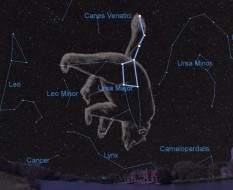Since ancient times, civilizations have assigned constellations based on conspicuous patterns of stars in the night sky. These patterns were useful for astrological predictions, navigation, as well as for communication among astronomers. But as the modern field of astronomy developed, discrepancies between different culturally nominated constellations made communication imprecise. In 1930, the International Astronomical Union (IAU) divided the sky into 88 constellations. Each constellation is defined by an imaginary boundary on the sky and named after a classical star pattern within those boundaries. So when we say a star is “in” a particular constellation, we don’t mean it’s necessarily part of the recognizable pattern of stars; rather, it simply lies within the IAU-defined boundaries of that constellation.

Starry Night Software / A.Fazekas
Asterisms are recognizable patterns of stars that are not officially designated constellations. An asterism might form part of an official constellation, like the Big Dipper, which is composed of the seven brightest stars in the constellation Ursa Major. Or the constellation might be made up of stars from different constellations. For example, the three points of the Summer Triangle asterism are Deneb, Altair, and Vega, which are the brightest stars in the constellations Cygnus, Aquila, and Lyra, respectively.
Learn the constellations in your sky with our Northern Hemisphere and Southern Hemisphere star wheels.
Are the stars in a constellation the same distance from us?
No. There are a few exceptions to the rule, but generally speaking, the stars in constellations have no physical connection with one another. Stars are distributed three-dimensionally in space, all with different distances from Earth. We group stars together in constellations based solely on their relative positions on the sky’s imaginary two-dimensional plane. If you changed your perspective by travelling to a planet around another star many light years away, you would see entirely new patterns in the stars.
Are the constellations permanent?
The constellations we see throughout the year change as Earth orbits the Sun, because Earth’s night-time side faces opposite directions relative to the stars in summer than in winter. But over the course of a human lifetime, the constellations will remain fairly static. While other stars do move relative to the Sun, typically at tens of kilometers per second, the vast distances between stars prevent these motions from having a noticeable effect on the night sky.
But millennia will tell a different story. In 50,000 years, some of today’s famed patterns in the sky will look significantly different due to the relative motions of the stars.
 0
0








Comments
You must be logged in to post a comment.